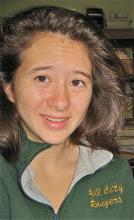February 15, 2013 | by Lynn Taylor Rick
As she battles a life-threatening disease, Shelby Huff won't be inside a Hill City classroom for another year — at least not physically.
But if her classmates and her community have anything to say about it, Shelby will be there virtually with the help of an interactive robot called VGo.
The robot, which looks much like a Segway, stands several feet tall and has a camera, microphone and video screen that will move from room to room in the school throughout the day. Via its technology, it will keep Shelby in close contact with her teachers and friends even though she will be at home recuperating.
Shelby, 16, was diagnosed in November with a condition called very severe aplastic anemia. Aplastic anemia occurs when the bone marrow stops making enough red and white blood cells and platelets. People with the "very severe" form face life-threatening infections and bleeding.
Within 90 minutes of the official diagnosis on Nov. 20 in Custer, Shelby was on a plane to Sanford Hospital in Sioux Falls for treatment. She has remained there ever since.
"Everything went upside down, but we had no idea how far upside down at that time," said Shelby's grandmother, Linda Brown of Hill City.
Shelby lives with her grandparents, Sam and Linda Brown. Her mother, Jennyfer Huff, lives in Florida and arrived in Sioux Falls shortly after the diagnosis.
The teenager spent nearly 50 consecutive days in the hospital, being treated with various medications and receiving twice weekly platelet transfusions. She remains in Sioux Falls, living in the Ronald McDonald House with a rotating list of relatives accompanying her.
She continues to receive twice-weekly blood transfusions and undergo immunosuppressive therapy, a treatment that weakens the immune system so the marrow can make more blood cells.
While the immunosuppressive therapy fights the anemia, it leaves her vulnerable to infections by weakening her immune system's response to germs. Even when Shelby returns to Hill City — hopefully in the next two to three weeks — she won't be able to return to a school building until Christmas. Having teachers visit her at home is also risky due to their exposure to students and germs throughout the day.
That's where VGo comes in.
Virtual, but very real
VGo is a robot that allows a person at a different location to see and hear what's going on wherever the robot is located.
In this situation, Shelby would remain safe in her grandparent's home and remotely direct the robot to move from class to class. Through the video capabilities, she would be able to hear and see what is happening in each classroom as if she were there.
On the school end, teachers and students would be able to see Shelby on the robot's video screen. She would be able to talk to teachers and hear their responses.
"It would be absolutely wonderful for her. She's an extremely social person," said Brown, her grandmother.
When Jennyfer Huff learned about the VGO robot, she immediately thought of her daughter, a self-described social person. "I miss every class. I loved being in school," Shelby said.
Officials at Hill City High were open to the idea from the start, Principal Todd Satter said.
Satter said he loves the idea that Shelby, and eventually other students who are incapacitated, could use the robot to continue their schooling.
"Shelby really can do all the work the kids are doing in class," he said. "It allows her to be in school virtually."
Hill City supports Shelby
Of course, the robot isn't cheap; Satter said it will cost about $7,200. The Hill City High School Student Council has taken on the challenge of raising the money, holding a hot dog eating contest recently and planning for an upcoming walking taco feed.
They were also able to keep the proceeds from a concession stand during a recent basketball game.
"Even parents from the opposing team donated," Satter said.
Satter said Hill City residents have also stepped up. "People have been writing checks," he said. "I'm pretty confident we're going to get there."
Shelby is excited about the possibility of at least "virtually" being back at school, and she's grateful for the "tons of letters" from friends and acquaintances. She's not all that surprised that her schoolmates would step up to help her.
"It's very cool," she said.
Doctors are optimistic about Shelby's long-term prognosis, hoping that the year-long treatments, which will include weekly blood transfusions in Sioux Falls, will eventually "reboot" her system.
The cure rate of the disease has risen to 70 percent with current therapies, Brown said. If the medications don't cure her, doctors will also consider a bone-marrow transplant, but the family doesn't want to have to go that route.
"We would really like to see this succeed for her," Brown said.
In the meantime, Shelby does her best to keep up with school work with a Sioux Falls teacher who visits her at Sanford. Getting back home to Hill City and her friends is her ultimate goal, even if most of the contact will be virtual for now.
"It's been really difficult being away from friends," she said. "I am ready to go home."
Article from The Rapid City News

